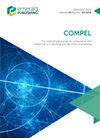The system for distributed energy resources testing according to the IEEE 1547-2018 standard
IF 1
4区 工程技术
Q4 COMPUTER SCIENCE, INTERDISCIPLINARY APPLICATIONS
Compel-The International Journal for Computation and Mathematics in Electrical and Electronic Engineering
Pub Date : 2023-08-24
DOI:10.1108/compel-01-2023-0023
引用次数: 0
Abstract
Purpose This paper aims to propose a new approach to testing distributed energy resources (DERs) in compliance with the IEEE 1547-2018 standard and describes a new, integrated testing and validation system. Design/methodology/approach The system is built on the virtual instrumentation paradigm, using acquisition modules to measure physical quantities, while signal processing, including intensive calculations of required parameters, data processing, manipulation and reporting are performed on a computing device. Findings Intensive laboratory measurements were performed on a laboratory prototype of a microgrid that emulates DERs. The results obtained using the system described were compared with the measurements obtained by the reference instruments. As all the results match, the usability of the system was verified. Practical implications This approach to the realization of the testing and validation system has obvious advantages compared to the classical instruments and provides significant flexibility in multiple aspects. First, the system described integrates all the functions of different instruments into one measuring system, making the entire testing and validation process significantly cheaper and faster. Second, the implementation of the system is possible on different computing platforms depending on specific needs. Third, the software implementation of the system functions enables simple upgrading and the introduction of new functions or changes to existing ones according to changes in the standard. Finally, the system described is designed to automatically provide reports on compliance with the standard. Originality/value This paper emphasizes the advantages of the proposed approach over classical testing. The value of the paper is reflected in the applicability and practical implications of the proposed and described hardware and software technical solutions.分布式能源测试系统符合IEEE 1547-2018标准
本文旨在提出一种符合IEEE 1547-2018标准的分布式能源(DERs)测试新方法,并描述了一种新的集成测试和验证系统。设计/方法/方法该系统建立在虚拟仪器范式的基础上,使用采集模块测量物理量,而信号处理,包括所需参数的密集计算、数据处理、操作和报告在计算设备上执行。在模拟DERs的微电网实验室原型上进行了密集的实验室测量。用该系统得到的测量结果与参考仪器得到的测量结果进行了比较。结果吻合,验证了系统的可用性。与传统仪器相比,这种测试验证系统的实现方法具有明显的优势,并且在多个方面提供了显著的灵活性。首先,所描述的系统将不同仪器的所有功能集成到一个测量系统中,使整个测试和验证过程显着便宜和快速。其次,根据具体需要,系统可以在不同的计算平台上实现。第三,系统功能的软件实现,可以根据标准的变化进行简单的升级和引入新功能或对现有功能进行更改。最后,所描述的系统旨在自动提供符合标准的报告。原创性/价值本文强调了所提出的方法相对于经典测试的优势。本文的价值体现在提出和描述的硬件和软件技术解决方案的适用性和实际意义上。
本文章由计算机程序翻译,如有差异,请以英文原文为准。
求助全文
约1分钟内获得全文
求助全文
来源期刊

CiteScore
1.60
自引率
0.00%
发文量
124
审稿时长
4.2 months
期刊介绍:
COMPEL exists for the discussion and dissemination of computational and analytical methods in electrical and electronic engineering. The main emphasis of papers should be on methods and new techniques, or the application of existing techniques in a novel way. Whilst papers with immediate application to particular engineering problems are welcome, so too are papers that form a basis for further development in the area of study. A double-blind review process ensures the content''s validity and relevance.
 求助内容:
求助内容: 应助结果提醒方式:
应助结果提醒方式:


